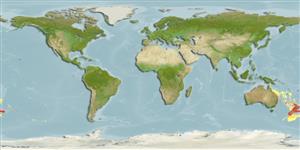Common names from other countries
分类 / Names
俗名 | 同种异名 | Catalog of Fishes(属, 种) | ITIS | CoL | WoRMS | Cloffa
Myxini
盲鳗纲 (丑鱼) (hagfishes) >
Myxiniformes (Hagfishes) >
Myxinidae (Hagfishes) > Eptatretinae
Etymology: Eptatretus: hepta (Gr.), seven; tretos (Gr.), perforated (i.e., with holes), referring to seven gill apertures on what would later be described as Homea banksii (=E. cirrhatus) [range within genus is 6-14 pairs of gill apertures]. (See ETYFish); cirrhatus: Latin for having tendrils, i.e., presumed to be a species of “lamprey” with barbels. (See ETYFish).
More on author: Forster.
Environment: milieu / climate zone / depth range / distribution range
生态学
海洋 深海底的; 非迁移的; 深度上下限 0 - 1100 m (Ref. 89422), usually 40 - 700 m (Ref. 31276). 深水域
Western Pacific: southern and eastern Australia and New Zealand.
西太平洋: 澳洲南部和西部與紐西蘭.(參考文獻 5755)
大小 / 重量 / 年龄
Maturity: Lm ? range ? - ? cm
Max length : 97.0 cm TL 雄鱼/尚未辨别雌雄; (Ref. 101563)
简单描述
检索表 | 型态特徵 | 形态测量图
背棘 (总数) : 0; 背的软条 (总数) : 0; 臀棘: 0; 臀鳍软条: 0. This species differs from all its congeners except E. caribbeaus, E. goliath, E. menezesi and E. strahani by having 7 pairs of gill pouches and three-cusp multicusps on the anterior and posterior rows of cusps. It differs from E. caribbeaus in number of anterior unicusps (8-11 vs. 11-13), posterior unicusps (7-9 vs. 10-11), total cusps (43-51 vs. 54-58) and prebranchial pores (16-20 vs. 13-15); from E. goliath in number of anterior unicusps (8-11 vs. 11-13), total cusps (43-51 vs. 54) and trunk pores (46-53 vs. 57-58); from E. menezesi in number of posterior unicusps (7-9 vs. 9-12), total cusps (43-51 vs. 52-60), tail pores (10-14 vs. 14-18); from E. strahani by its number of prebranchial pores (16-20 vs. 13-16) (Ref. 85052).
没有鳍条的中央的鳍.(参考文献 9841)
Occurs on soft bottoms of the continental slope (Ref. 7300). Able to form locally abundant populations and is often associated with inshore reefs (Ref. 85052).
生活于大陆斜坡的软质底部。 (参考文献 7300)
Life cycle and mating behavior
Maturities | 繁殖 | Spawnings | Egg(s) | Fecundities | 仔鱼
Copulatory organ absent. The gonads of hagfishes are situated in the peritoneal cavity. The ovary is found in the anterior portion of the gonad, and the testis is found in the posterior part. The animal becomes female if the cranial part of the gonad develops or male if the caudal part undergoes differentiation. If none develops, then the animal becomes sterile. If both anterior and posterior parts develop, then the animal becomes a functional hermaphrodite. However, hermaphroditism being characterised as functional needs to be validated by more reproduction studies (Ref. 51361 ).西太平洋: 澳洲南部和西部與紐西蘭.(參考文獻 5755)
Fernholm, B., 1998. Hagfish systematics. p. 33-44. In J.M. Jørgensen, J.P. Lomholt, R.E. Weber and H. Malte (eds.) The biology of hagfishes. Chapman & Hall, London. 578 p. (Ref. 31276)
CITES (Ref. 128078)
Not Evaluated
人类利用
渔业: 商业性
工具
特别资料
下载 XML
网络资源
Estimates based on models
Preferred temperature (Ref.
115969): 7.8 - 21, mean 12.3 (based on 188 cells).
Phylogenetic diversity index (Ref.
82804): PD
50 = 0.5000 [Uniqueness, from 0.5 = low to 2.0 = high].
Bayesian length-weight: a=0.00295 (0.00163 - 0.00533), b=2.95 (2.78 - 3.12), in cm Total Length, based on LWR estimates for this species & (Sub)family-body (Ref.
93245).
营养阶层 (Ref.
69278): 2.0 ±0.00 se; based on food items.
回复力 (Ref.
120179): 低的, 最小族群倍增时间4.5 - 14 年 (Fec assumed to be <100).
Fishing Vulnerability (Ref.
59153): High vulnerability (59 of 100).
